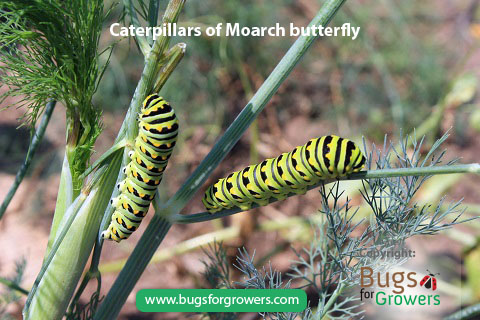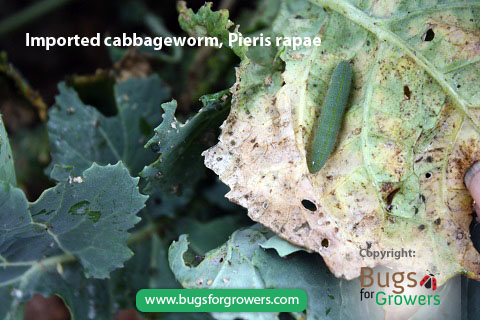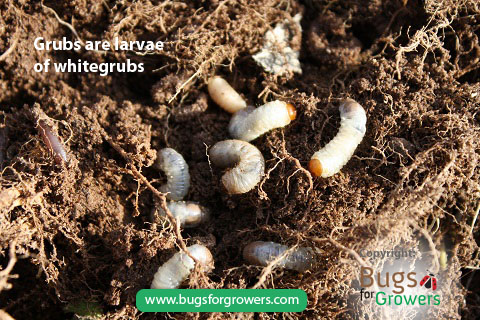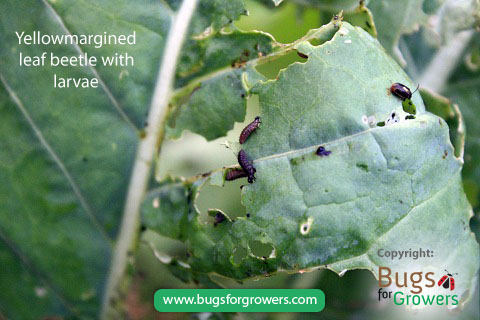Predatory spined soldier bug, Podisus maculiventris for the control of yellowmargined leaf beetle, Microtheca ochroloma
Predatory spined soldier bug is scientifically known as Podisus maculiventris. As name implies, these bugs have two spines (Fig. 1), one on each side of thorax (humeral angle). These bugs also recognized as stink bugs because they are known to emit strong odor when disturbed. These predatory spined soldier bugs are considered as the most effective biological control agents because they have a wide host range and feed on insect stages that are responsible for causing the most damage to crops. Adult spined soldier bugs are yellowish brown in color, about 12 mm long and 7.5 mm wide, and they have shield shaped body.These bugs overwinter as adults under previous crop residues. Female bugs lay eggs in masses on the upper surface of leaves and twigs. Eggs hatch within a week into small nymphs, which develop through five instars/stages and become adults. All the five nymphal instars look alike and they possess black colored head and thorax, and reddish abdomen. Except first instar nymphs, all the nymphs and adults are predatory in nature. Both the nymphs and adults have piercing and sucking type of mouthparts also called beaks. These beaks are used for injecting a paralyzing toxic substance into host caterpillars (Fig. 2.) also called larvae (Fig. 3) or grubs (Fig. 4). These beaks are also used for feeding on the body content of the paralyzed host larvae or grubs.




These predatory spined soldier bugs generally kill and feed on the larval stages of insects that mainly belong to two insect orders including Lepidoptera and Coleoptera. Major Lepidopterous host insects of predatory spined soldier bug include banana skipper (Erionota thrax), beet armyworm (Spodoptera exigua), cabbage looper (Trichoplusia ni), cabbage worm (Pieris brassicae), corn earworm (Heliothis zea), cross-striped cabbage worm (Evergestis rimosalis), diamondback moth (Plutella xylostella), European corn borer (Ostrinia nubilalis), fall armyworm (Spodoptera frugiperda), fruit piercing moth (Eudocima fullonia), imported cabbageworm (Pieris rapae; Fig. 3), poinciana looper (Pericyma cruegeri) and velvetbean caterpillar (Anticarsia gemmatalis). The Coleopterous host insects include Colorado potato beetle (Leptinotarsa decemlineata), Mexican bean beetle (Epilachna varivestis) and yellowmargined leaf beetle, Microtheca ochroloma (Fig. 5).
What are yellowmargined leaf beetles, Microtheca ochroloma?
The yellowmargined leaf beetles, Microtheca ochroloma got their name because the margins of their forewings also called elytra are yellow in color (Fig. 5). These are tiny beetles about 5-6 mm long, dark brownish black in color and overwinter as adults. Female beetles lay elongated orange colored eggs on plant stems. These eggs hatch into small brown colored larvae also called grubs (Fig. 5) . These grubs develop through 3-4 instars/stages. The mature larvae pupate in cocoons that are generally attached to lower surface of leaves. Adults emerge from pupae within a couple of days and start feeding on the leaves. While feeding females mate and lay eggs, and life cycle continues.
The yellowmargined leaf beetles, Microtheca ochroloma are serious pests of mainly cruciferous (Brassica spp.) crops including broccoli, cabbage, cauliflower, collards, mustard, radish and turnip. Both the adults and larvae feed voraciously on the foliage of host plants and in severe cases they can completely defoliate plants. While feeding, they generally make small holes in leaves and on their margins.

Biological control of yellowmargined leaf beetles, Microtheca ochroloma
Several different chemical insecticides may be effective in controlling these yellowmargined leaf beetles but their use should be restricted in home gardens due to their detrimental effects on human health, pet and wild animals, and the environment. Recently, Montemayor and Cave (2011) tested effect of predatory spined soldier bug, Podisus maculiventris against yellowmargined leaf beetles, Microtheca ochroloma. The results of this study suggest that the spined soldier bugs have potential to use as biological control agents for the management of leaf beetles.
How Predatory spined soldier bug, Podisus maculiventris will kill and feed on yellowmargined leaf beetles, Microtheca ochroloma?
Predatory spined soldier bugs are supplied as eggs, which are close to hatch or as nymphs. When you release nymphs in the field or greenhouse, they will actively search for grubs of yellowmargined leaf beetles, Microtheca ochroloma. Once grubs are found, both nymphs and adults can attack these grubs and inject toxic paralyzing substance into their bodies. This injected toxin will paralyze beetle grubs within a few seconds. Then both the nymphs and adults of predatory spined soldier bugs will use their piercing and sucking type of mouthparts (beaks) to feed on the body content of paralysed grubs of leaf beetles, Microtheca ochroloma. This process of injecting toxic material and feeding by predatory spined soldier bugs will eventually kill the grubs that in turn will stop the production of future generations of yellowmargined leaf beetles, Microtheca ochroloma.
Research Papers
- Montemayor, C.O. and Cave, R.D. 2011. Development Time and Predation Rate of Podisus maculiventris (Hemiptera: Pentatomidae) Feeding on Microtheca ochroloma (Coleoptera: Chrysomelidae). Environmental Entomology 40: 948-954.
- Montemayor, C.O. and Cave, R.D. 2012. Evaluation of the Predation Capacity of Podisus maculiventris (Hemiptera: Pentatomidae) on Microtheca ochroloma (Coleoptera: Chrysomelidae) in Field Cages. Journal of Economic Entomology 105: 1719-1725.
